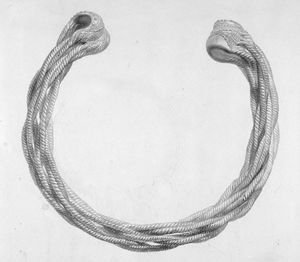Technologies of enchantment: Celtic Art in Iron Age and Roman Britain
Duncan Garrow, Chris Gosden, JD Hill, 2009. https://doi.org/10.5284/1000086. How to cite using this DOI
Data copyright © Duncan Garrow unless otherwise stated
This work is licensed under the ADS Terms of Use and Access.
Primary contact
Duncan
Garrow
Department of Archaeology
University of Liverpool
Hartley Building
Brownlow Street
Liverpool
L69 3GS
UK
Resource identifiers
- ADS Collection: 933
- DOI:https://doi.org/10.5284/1000086
- How to cite using this DOI
Introduction

Multi-stranded torc from Needwood Forest, Staffordshire. Image from the Society of Antiquaries Catalogue of Drawings & Museum Objects.
This AHRC funded project - entitled 'Technologies of enchantment: Celtic Art in Iron Age and Roman Britain' - aimed to investigate the artefacts found in Britain between about 300 BC and 150 AD which have come to be known as 'Celtic Art'. Although, in recent years, questions have been raised about whether the Celts actually did exist as a distinct group of people, the term 'Celtic Art' continues to be used to describe a group of distinctively decorated objects found right across Europe during the later Iron Age and early Roman periods.
The Celtic Art style incorporates abstract patterns, along with semi-abstract and naturalistic human, animal and plant imagery. It is clearly distinguishable from Roman and Greek Classical art of the same date. The majority of Celtic Art objects are made of metal (including bronze, iron, gold and silver). However, the distinctive decorative patterns are also found occasionally on objects made from bone, wood and pottery. Some of the most famous items are the torcs buried at Snettisham, the Battersea shield which was deposited in the River Thames, and several bronze mirrors found mostly in southern Britain.
In the past, Celtic Art has been analysed in much the same way as more recent paintings and sculpture: people have focused on the various motifs decorating the objects and discussed how they changed gradually over time. The aim of this project, however, is to place these undeniably beautiful artefacts back into their archaeological contexts and to investigate how they fitted into the Iron Age and Romano-British societies in which they were made.






